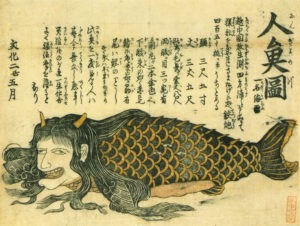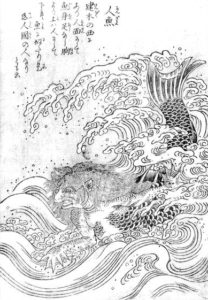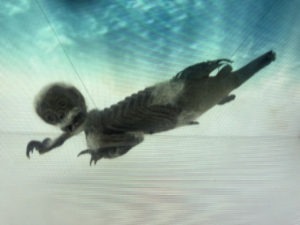Anyone who has seen a Fiji mermaid is not soon to forget it. Unlike the alluring siren imagery we are familiar with, a Fiji mermaid can be a rather disquieting sight. With a mummified and animalistic appearance, these oddities have fascinated people for years. Once thought to be authentic specimens, they are now acknowledged as artificial constructions. They can still be found on display at a variety of institutions, and I was quite pleased to happen upon one in Orlando, Florida.
Fiji mermaids (also spelled Feejee or Fejee) came to prominence in the US and UK during the 1800s. Showman P.T. Barnum exhibited what likely became the most famous specimen. It was approximately 3 feet long, positioned vertically, and had a grotesque appearance. The creature was likely constructed using the upper half of an orangutan and the lower half of a salmon. Thanks to Barnum’s skill at promotion, this exhibit became extremely popular in New York, toured the Southern US, and ended up on display at a Boston museum. (Its whereabouts today are unknown and it may have been destroyed in a fire.)

Barnum’s advertisement for the mermaid – Source: Wikimedia Commons
Although some denounced Barnum’s mermaid as a hoax, overall it generated extreme interest. In due time, other mermaid specimens began appearing in the collections of various institutions. The construction of these other mermaids usually involved the top half of some simian species, along with the lower half of a fish of corresponding size. They may have been further built out with other materials.

Illustration of the actual mermaid exhibit – Source: Wikimedia Commons
Despite the name, these mermaids aren’t from Fiji – that was just part of a fictitious backstory created by Barnum. Japanese fisherman likely made Barnum’s mermaid in the early 1800s. It was then purchased by Dutch sailors and eventually found its way to the US. One hypothesis is that that mermaid was put together as a joke. Others have stated that these figures were often made in Japan and the East Indies for religious purposes. As Japan opened up for trade during the 19thcentury, these mermaids became popular items.
Although the appearance of these mermaids is surprising for Western audiences, they are actually consistent with Japanese folklore. In Japan, there was a belief in creatures known as ningyo (which translates to “human fish”). In some traditions, the ningyo appears as a fish with a human head. Other descriptions may include arms, horns, or razor sharp teeth. They are not portrayed as attractive or alluring. Catching one may result in disaster, though eating the flesh of the ningyo can grant exceptionally long life. Today, one Japanese temple displays bones from a supposed ningyo that date back to 1222. Another temple has a mummified ningyo that is purported to be 1400 years old! It’s interesting to note that this mummy bears a striking resemblance to the Fiji mermaids.

Ningyo Illustration from Japan, 1805 – Source: Wikimedia Commons

Ningyo Illustratino from Japan, 1780 – Source: Wikimedia Commons
The Fiji mermaid I saw was at the Ripley’s Believe It or Not! museum in Orlando, Florida. When I visited, it was in the first exhibit room. Its case has the appearance of a red, wooden crate. The front panel is transparent, allowing a view into the box where the mermaid is suspended on wires. Informative text and related pictures are projected in a loop onto that front panel. The mermaid has a mummified look with a grimacing expression, small claws, and white tufts of hair. It’s fantastically creepy and certainly makes an impact. I really enjoyed seeing it along with all the other oddities on display!
Location
Ripley’s Believe It or Not!
8201 International Drive
Orlando, FL, 32819
Official Site: https://www.ripleys.com/orlando/
Sources
Krishna, Swapna. “How 13th-Century ‘Mermaid Bones’ Came to Be Displayed in a Japanese Temple.” Smithsonian Magazine. February 16, 2017. https://www.smithsonianmag.com/smart-news/how-13th-century-mermaid-bones-came-be-displayed-japanese-temple-180962209/.
Meier, Allison. “How a Fake Monster Crept Into our Museums.” Hyperallergic. January 15, 2018. https://hyperallergic.com/421405/how-a-fake-monster-creeped-into-our-museums/.
“Ningyo.” Yokai.com. http://yokai.com/ningyo/.
Szalay, Jessie. “The Feejee Mermaid: Early Barnum Hoax.” Live Science. September 9, 2016. https://www.livescience.com/56037-feejee-mermaid.html.
“Tenshou-Kyousha Shrine Mermaid Mummy.” Atlas Obscura. https://www.atlasobscura.com/places/fujinomiya-mermaid-mummy.
Written by A. P. Sylvia



